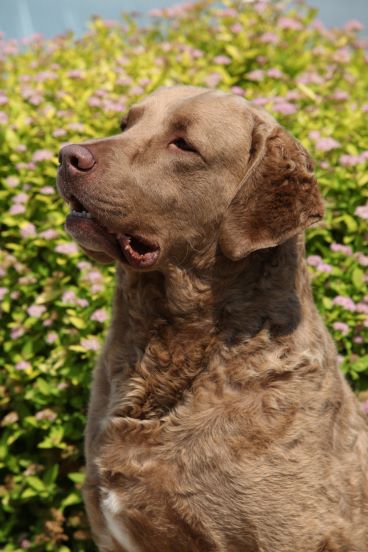Chesapeake Bay Retriever: An Enthusiast’s Guide to Traits & Characteristics
Introduction to Chesapeake Bay Retrievers
As an enthusiast and advisor around large dog breeds, I often find myself gravitating towards the Chesapeake Bay Retriever. Why, you might ask?
A Brief History of the Breed
The Chesapeake Bay Retriever, fondly known as the “Chessie”, traces its origins back to the American Chesapeake Bay area. This breed has a storied past, with roots in waterfowl hunting, assisting hunters in the icy waters of the bay.
The Distinct Look of Chesapeake Bay Retrievers
With a dense double coat and an athletic body, these retrievers exhibit an alluring blend of ruggedness and charm. Their eyes, typically of amber or light brown color, project a warm, intelligent gaze.
Personality and Temperament Traits of Chesapeake Bay Retrievers
Now that we’ve covered the basics, let’s dive into the heart of the matter – the temperament and traits of these stunning dogs.
The Loyal Friend: Understanding Their Devotion
Chessies are renowned for their devotion to their family. They form strong bonds and are protective, making them excellent family dogs.
The Energetic Companion: Unpacking Their Energy Levels
Owing to their working dog heritage, Chesapeake Bay Retrievers have high energy levels. They thrive on physical activity and mental stimulation.
The Intelligent Partner: Recognizing Their Smartness
Chessies are highly intelligent, known for their problem-solving abilities. They enjoy challenging tasks and games, which helps keep them mentally stimulated.
Caring for a Chesapeake Bay Retriever
So, what does it take to care for a Chesapeake Bay Retriever?
The Dietary Needs of Chesapeake Bay Retrievers
Like all large breeds, Chessies require a balanced diet rich in proteins, carbohydrates, fats, vitamins, and minerals.
Exercise and Activity Requirements
As high-energy dogs, Chesapeake Bay Retrievers need ample exercise. Regular walks, playtime, and swimming are excellent ways to keep them fit.
Grooming Your Chesapeake Bay Retriever
Their thick coat requires weekly brushing to keep it healthy and shiny. Beyond that, they are relatively low-maintenance dogs.
Training Your Chesapeake Bay Retriever
The Importance of Early Socialization
Socializing your Chessie from a young age is crucial to ensure they grow up to be well-rounded dogs.
Effective Training Methods for This Breed
Positive reinforcement methods work best for this breed. Consistency and patience are key when training these intelligent dogs.
Common Health Issues in Chesapeake Bay Retrievers
Like all breeds, Chessies are prone to certain health issues like hip dysplasia, eye problems, and certain types of cancer. Regular vet check-ups are crucial.
Conclusion: Why Choose a Chesapeake Bay Retriever?
In conclusion, the Chesapeake Bay Retriever is a loyal, energetic, and intelligent breed that makes an excellent companion for active and loving families. With the right care and training, a Chessie can bring a lot of joy and fulfillment into your life.
Frequently Asked Questions
- Are Chesapeake Bay Retrievers good family dogs?Absolutely! Chesapeake Bay Retrievers are known for their loyalty and devotion towards their families. They are protective and form strong bonds with their family members. However, due to their high energy levels and size, they may be better suited for families with older children.
- How much exercise does a Chesapeake Bay Retriever need?Being a high-energy breed, Chesapeake Bay Retrievers need substantial exercise to keep them healthy and content. This typically means at least one to two hours of physical activity per day. Activities can include walking, running, playing fetch, or swimming. They are particularly fond of activities that engage their mind as well as their body, so interactive games or dog sports can be a great choice.
- What health issues are common in Chesapeake Bay Retrievers?Chesapeake Bay Retrievers, like any breed, can be prone to certain health conditions. Some of the most common include hip and elbow dysplasia, progressive retinal atrophy, and certain types of cancer. Regular check-ups with your vet can help detect any issues early and keep your Chessie healthy.
- How do I train my Chesapeake Bay Retriever?Chesapeake Bay Retrievers are intelligent dogs that respond well to training. It’s important to start training and socializing your Chessie from a young age. Use positive reinforcement techniques such as treats, praise, and play. Keep in mind that this breed can be somewhat stubborn, so consistency and patience are key.
- What is the lifespan of a Chesapeake Bay Retriever?The average lifespan of a Chesapeake Bay Retriever is around 10-13 years. However, with proper care, regular exercise, and a balanced diet, some Chessies can live beyond this range. Regular veterinary check-ups are important to ensure your Chessie stays healthy throughout their life.




